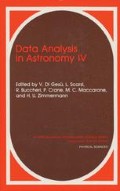Abstract
We describe initial experiments in detecting cosmic ray hits on single Hubble Space Telescope Wide Field/Planetary Camera CCD-frames. Classifiers are trained on images with (what are considered to be) the cosmic ray hits marked. A range of classifiers are assessed. The IRAF cosmicrays task is found to be conservative, having a low detection rate combined with a low false alarm rate. The classical k-nearest neighbours method offers a versatile and broad-ranging alternative. With the rather homogeneous input data used, the various multilayer perceptron algorithms used did not appear to offer advantages over the variants of k-nearest neighbours.
Access this chapter
Tax calculation will be finalised at checkout
Purchases are for personal use only
Preview
Unable to display preview. Download preview PDF.
References
Adorf, H.-M.. “WFPC: options for overcoming undersampling”, in C. Jaschek and F. Murtagh, Eds., Errors, Bias and Uncertainties in Astronomy, Cambridge U.P., New York, 1990, pp. 71–78.
Adorf, H.-M., “Cosmic ray detection on individual WF/PC frames”, ST-ECF Technical Report (DA)-21, 5 pp., April 1991.
Adorf, H.-M. and Meurs, E.J.A., “Supervised and unsupervised classification–the case of IRAS point sources”, in W.C. Seitter, H.W. Duerbeck and M. Tacke, Eds., Large-Scale Structures in the Universe–Observational and Analytical Methods, Springer-Verlag, Berlin, 315–322, 1988.
Barnard, E. and Cole, R., “A neural net training program based on conjugate-gradient”, Oregon Graduate Center TR CSE 89–015, Beaverton, Oregon, 1989.
Davies, E.R., “Training sets and a priori probabilities with the nearest neighbour method of pattern recognition”, Pattern Recognition Letters, 8, 11–13, 1988.
Griffiths, R., Hubble Space Telescope Wide Field and Planetary Camera Instrument Handbook, Version 2.1, Space Telescope Science Institute, Baltimore, 1990.
Lauer, T.R., “The reduction of Wide Field/Planetary Camera images”, Princeton Observatory preprint, Dec. 1988.
Melsa. J.L. and Cohn, D.L., Decision and Estimation Theory, McGraw-Hill, 1978.
Meurs, E.J.A. and Adorf, H.-M., “The selection of extragalactic source samples from the IRAS database”,Proc. Ile Rencontres de Blois,1991. in press
Murtagh, F., “Review of Y.-H. PaoAdaptive Pattern Recognition and Neural Networks”. Journal of Classification, 1991, in press.
Murtagh, F., “Multilayer perceptrons for classification and regression”,Neurocornputing, 1991b, in press.
Murtagh, F., “The multilayer perceptron for discriminant analysis: two examples”, Proc. 15. Jahrestagung der Gesellschaft fur Klassifikation, H. Goebl and M. Schader ( Eds. ), Springer-Verlag, 1991c. submitted.
Murtagh, F. and Heck, A., Multivariate Data Analysis, Kluwer Academic, 1985.
Pao, Y.-H., Adaptive Pattern Recognition and Neural Networks, Addison-Wesley, 1989.
Prusti. T., Adorf, H.-M., and Meurs, E.J.A., “Young stellar objects in the IRAS Point Source Catalog”, 1991, in preparation.
SAS, SAS User’s Guide: Statistics. SAS Institute, Cary, NC, 1985.
Author information
Authors and Affiliations
Editor information
Editors and Affiliations
Rights and permissions
Copyright information
© 1992 Springer Science+Business Media New York
About this chapter
Cite this chapter
Murtagh, F.D., Adorf, HM. (1992). Detecting Cosmic Ray Hits on HST WF/PC Images Using Neural Networks and Other Discriminant Analysis Approaches. In: Di Gesù, V., Scarsi, L., Buccheri, R., Crane, P., Maccarone, M.C., Zimmermann, H.U. (eds) Data Analysis in Astronomy IV. Ettore Majorana International Science Series, vol 59. Springer, Boston, MA. https://doi.org/10.1007/978-1-4615-3388-7_12
Download citation
DOI: https://doi.org/10.1007/978-1-4615-3388-7_12
Publisher Name: Springer, Boston, MA
Print ISBN: 978-1-4613-6496-2
Online ISBN: 978-1-4615-3388-7
eBook Packages: Springer Book Archive

